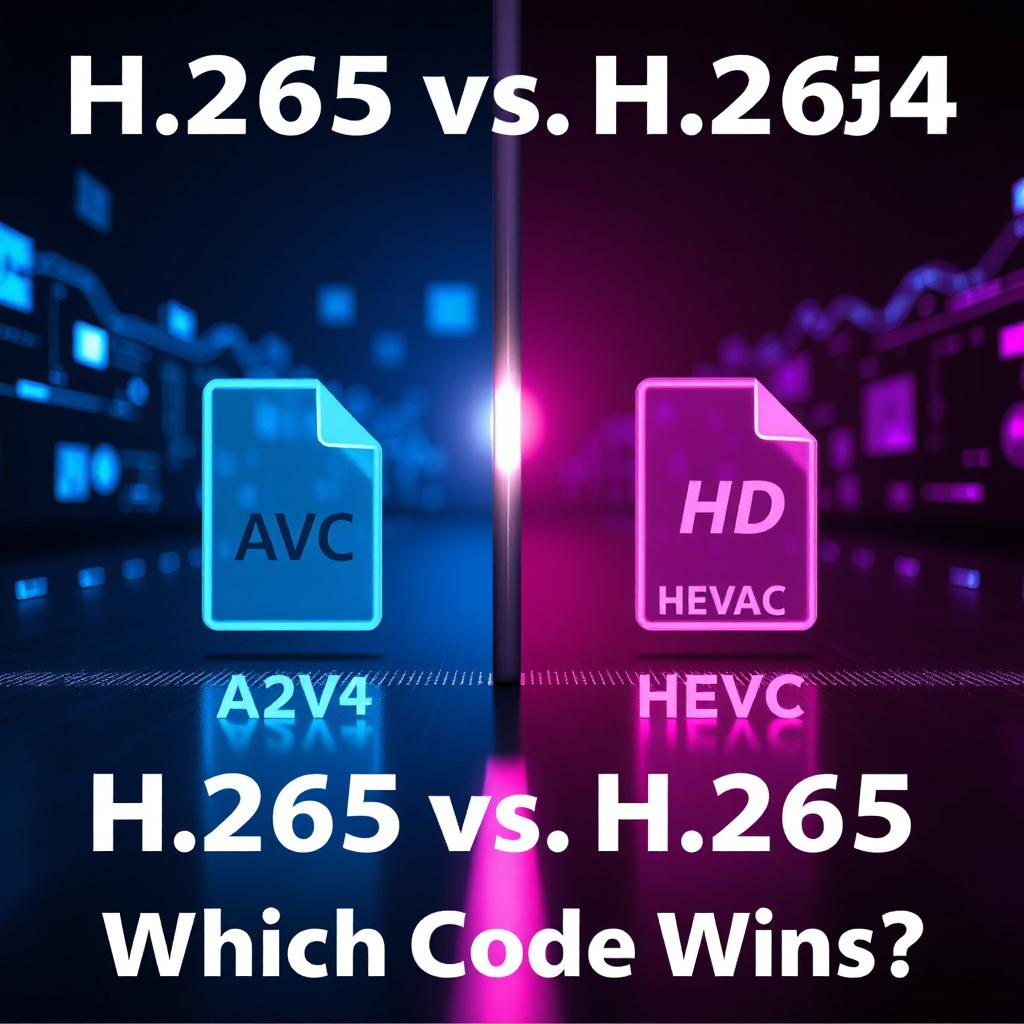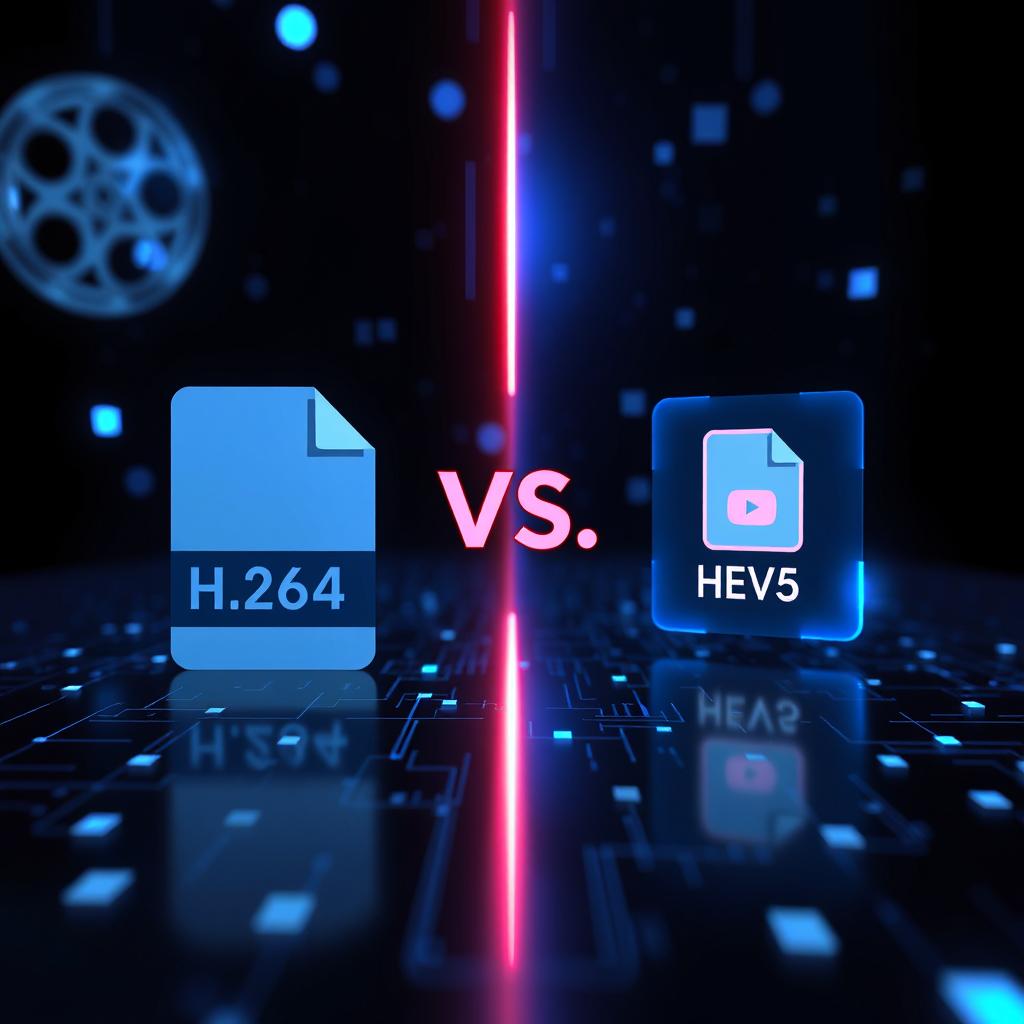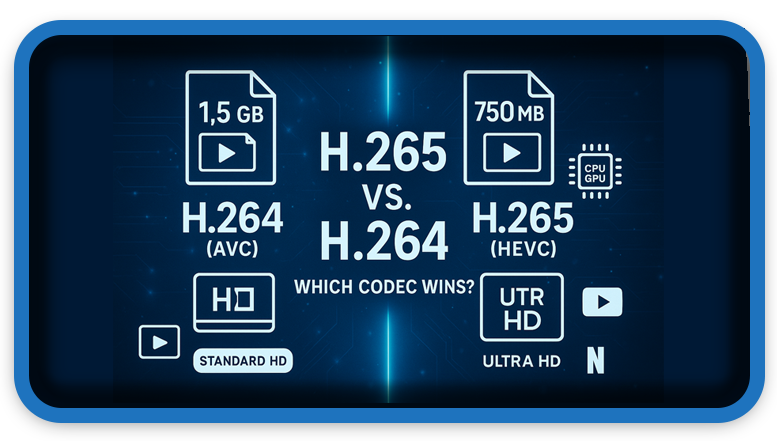⏲️ Estimated reading time: 5 min
✅ H.265 (HEVC) vs. H.264 (AVC): Which Video Codec Reigns Supreme in 2025?
H.265 (HEVC) vs. H.264 (AVC) are two of the most important video codecs used in digital streaming and video compression. While H.264 remains dominant, H.265 is gaining traction thanks to better compression and future-ready technology.
Let’s dive into the full comparison between the two and discover which one best suits your needs.
🔍 What Are H.264 and H.265?
📼 H.264 (AVC) – The Industry Veteran
H.264, also known as Advanced Video Coding (AVC), has been the standard video compression format since 2003. It became a dominant choice for streaming platforms, Blu-ray discs, and digital TV due to its excellent balance between compression and quality.
📽️ H.265 (HEVC) – The High-Efficiency Successor
H.265, or High-Efficiency Video Coding (HEVC), was developed as the successor to H.264. Released in 2013, HEVC improves upon its predecessor by offering up to 50% better compression while maintaining the same quality.
But there’s a catch while H.265 is technically superior, adoption has been slower due to hardware requirements and licensing complexities.
🧪 Compression Efficiency
H.264 Compression
H.264 compresses video by analyzing multiple frames and reducing redundancy, especially in static areas. It uses motion prediction and block-based transformations to store video efficiently.
- 🟢 Pros: Good quality at reasonable file sizes
- 🔴 Cons: Larger files compared to newer codecs
H.265 Compression
H.265 uses more advanced techniques such as larger coding tree units (CTUs) and asymmetric motion partitioning. This allows for significantly smaller file sizes.
- 🟢 Pros: 30–50% smaller file sizes at the same quality
- 🔴 Cons: Requires more CPU/GPU power for encoding/decoding
📊 Example Comparison:
| Resolution | Codec | File Size | Bitrate |
|---|---|---|---|
| 1080p | H.264 | 1.5 GB | 5 Mbps |
| 1080p | H.265 | 750 MB | 2.5 Mbps |

🎮 Performance and Hardware Requirements
CPU and GPU Load
H.265 is computationally heavier, requiring more powerful hardware to encode and decode videos, especially at 4K and 8K.
| Codec | Decoding Difficulty | Encoding Difficulty |
|---|---|---|
| H.264 | Low | Moderate |
| H.265 | Moderate | High |
If you’re using older devices or video editing software, H.264 offers greater compatibility and faster rendering.
Streaming and Mobile Devices
Most modern smartphones, smart TVs, and streaming devices (e.g., Roku, Apple TV, Firestick) support H.265. However, some budget or older devices only support H.264, especially on older Android phones or browsers.
🌐 Bandwidth and Streaming Efficiency
H.264 in Streaming
H.264 is widely supported on all browsers and platforms, including YouTube, Vimeo, and Facebook. It streams reliably on even slower internet connections but takes up more bandwidth compared to HEVC.
H.265 in Streaming
H.265 is ideal for 4K and HDR streaming. Services like Netflix and Amazon Prime Video use H.265 to stream UHD content more efficiently, saving bandwidth and improving playback.
⚠️ Note: Some web browsers like Safari support H.265 natively, while Chrome and Firefox may require WebAssembly decoders or fallback to H.264.
📂 Storage and File Sizes
One of the biggest advantages of H.265 is reduced file size:
- A 4K movie encoded with H.264 may be 20 GB, while H.265 brings it down to 10–12 GB.
- Useful for video archiving, surveillance systems, and media servers like Plex or Jellyfin.
This makes H.265 perfect for creators, editors, and archivists who want to save on storage costs without compromising quality.

🧰 Editing and Workflow Compatibility
While H.264 is easier to edit, H.265 is more demanding.
- H.264: Better support in Adobe Premiere, DaVinci Resolve, Final Cut Pro
- H.265: May require transcoding or proxy editing on older software/hardware
👨💻 For editors and YouTubers, H.264 remains the better choice for smoother editing unless you’re working with ultra-high-resolution content.
💸 Licensing and Royalties
H.264 (AVC) Licensing
H.264 licensing is managed by MPEG LA. While it involves licensing fees for certain uses, it has wider acceptance and fewer barriers for developers and hardware makers.
H.265 (HEVC) Licensing
H.265 licensing is more complex. It’s managed by multiple patent pools (MPEG LA, HEVC Advance, Velos Media), making it difficult and more expensive to implement in software and hardware.
🚨 This has slowed HEVC adoption, especially in open-source projects and small businesses.
🔄 Codec Support and Compatibility
| Feature | H.264 | H.265 |
|---|---|---|
| Browser Support | ✅ All | ⚠️ Limited |
| Streaming Compatibility | ✅ Excellent | ✅ Good (4K) |
| Smart TVs / Mobiles | ✅ All | ✅ Newer only |
| Editing Software Support | ✅ All | ⚠️ Limited |
| Hardware Decoding (2025) | ✅ Most | ✅ Flagships |
| File Size | 🔴 Larger | 🟢 Smaller |
⚖️ Use Cases: Which Codec to Choose?
Use H.264 (AVC) If You:
- Need maximum compatibility
- Are working with older devices or software
- Stream to general audiences (YouTube, social media)
- Want faster export and editing times
Use H.265 (HEVC) If You:
- Want the best compression for 4K or 8K
- Need to save disk space
- Stream UHD video (Netflix, Amazon Prime)
- Use modern hardware that supports HEVC natively
🚀 The Future: AV1 and Beyond?
As of 2025, both codecs are still in widespread use. However, a new contender has emerged: AV1, an open and royalty-free codec supported by companies like Google, Netflix, and Amazon.
AV1 promises even better compression than H.265 with no licensing fees. However, hardware decoding support is still maturing.
➡️ AV1 is not ready to replace H.265 or H.264 yet, but it’s one to watch for in the coming years.
🧠 Final Thoughts: H.265 (HEVC) vs. H.264 (AVC)
Choosing between H.264 and H.265 depends on your specific use case.
- If you value compatibility and speed, stick with H.264.
- If you need efficiency and quality for UHD, H.265 is your best bet assuming your hardware and audience can handle it.
In 2025, both codecs coexist, each serving different needs. And with AV1 on the horizon, the future of video compression continues to evolve.
🔔For more tutorials like this, consider subscribing to our blog.
📩 Do you have questions or suggestions? Leave a comment or contact us!
🏷️ Tags: h.264, h.265, video compression, hevc, avc, streaming codecs, video editing, video formats, 4k video, codec comparison
📢 Hashtags: #h264, #h265, #hevc, #avc, #videocodec, #streamingtech, #4kvideo, #editingsoftware, #techcomparison, #futureofvideo
📘 Wrap-Up: Codec Showdown in the Digital Age
Both H.264 and H.265 have carved out essential roles in the world of video. One is built for reliability, the other for efficiency. As a content creator, tech enthusiast, or developer, knowing their strengths ensures you make the right choice for every project.
Want to go deeper into AV1, VP9, or video editing workflows? Let us know your feedback helps shape our next posts!
Only logged-in users can submit reports.
Discover more from HelpZone
Subscribe to get the latest posts sent to your email.

